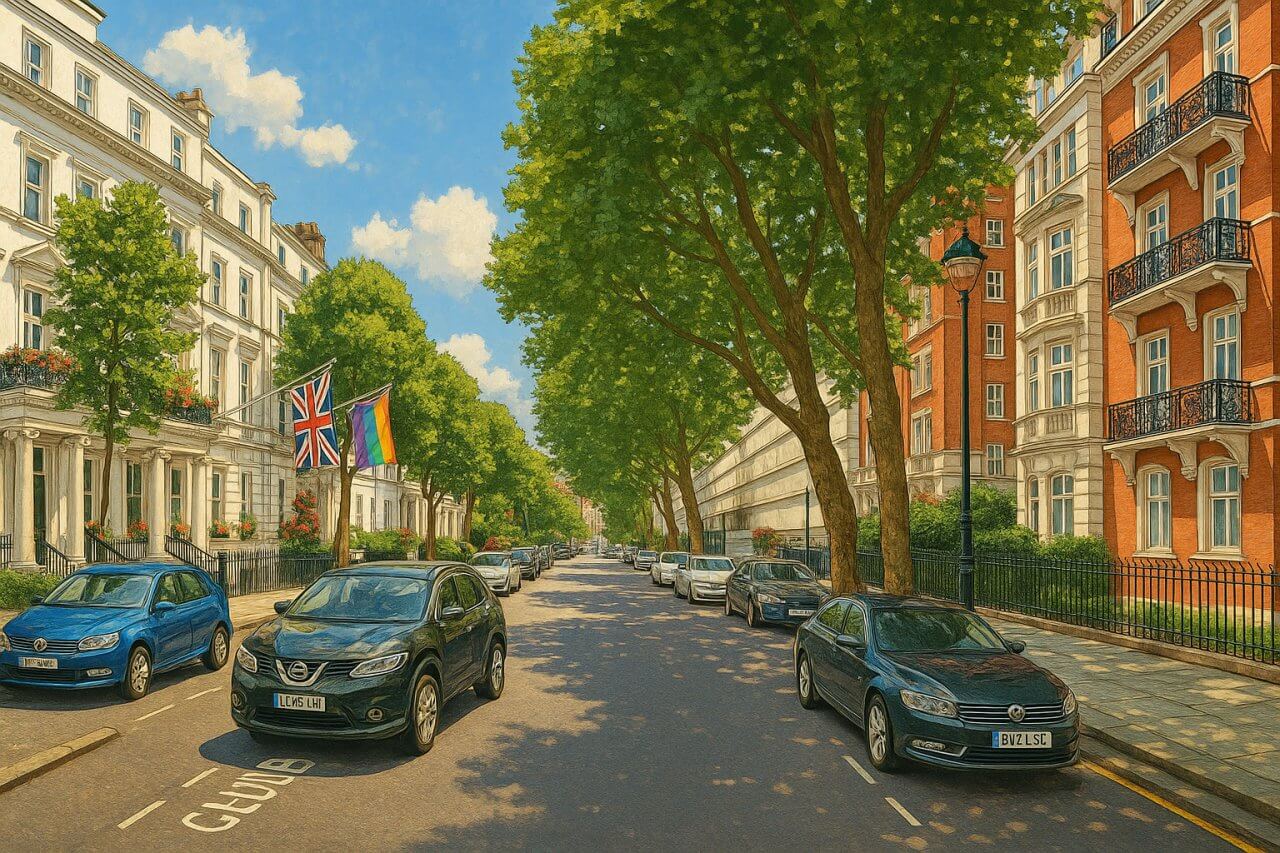
Kensington, London
Kensington is a prestigious and affluent neighbourhood in West London, known for its elegant architecture, cultural institutions, and green open spaces. It forms part of the Royal Borough of Kensington and Chelsea, although the name "Kensington" generally refers to the western portion of the borough, centring around Kensington High Street and Kensington Gardens. The area is bordered roughly by Notting Hill to the north, Chelsea to the south, Earl's Court to the west, and Hyde Park to the east.
Location and Boundaries
Kensington is situated in Zone 1 and Zone 2 of London’s transport network. It is about 3.5 miles west of central landmarks such as Trafalgar Square. The heart of Kensington is generally considered to be Kensington High Street, which runs west from Kensington Road and continues into Hammersmith.
Area Size and Population
The Kensington neighbourhood, while lacking official boundaries separate from the larger borough, covers an area of approximately 2.75 square kilometres (1.06 square miles). As part of the wider Kensington and Chelsea borough, Kensington itself is estimated to have a population of around 60,000, though precise numbers vary depending on the specific boundaries used.
Demographics
Kensington is home to a diverse, cosmopolitan population. While it has long been associated with affluent British families, it also includes a significant number of foreign residents, diplomats, and professionals from Europe, North America, and the Middle East. Over 40% of residents in Kensington and Chelsea are foreign-born1. English is the primary language, but many other languages are spoken, including French, Arabic, and Italian.
Income and Socioeconomics
Kensington is one of the wealthiest neighbourhoods in the UK. The per capita income here is estimated to exceed £60,000, compared to the London average of approximately £38,0002. Many residents are high earners, working in finance, law, government, or the arts. There is also a notable presence of retired individuals living in long-established family properties.
Major Roads in Kensington
The area is defined by several important roads:
- Kensington High Street – the commercial and retail heart of the district
- Kensington Church Street – linking Notting Hill Gate with Kensington High Street
- Kensington Gore – running alongside the Royal Albert Hall
- Holland Road – a major thoroughfare leading toward Shepherd’s Bush
- Gloucester Road – home to embassies, hotels, and restaurants
Map of Kensington, London
Kensington Street Index
Transport and Underground Stations
Kensington is exceptionally well-connected via the London Underground and bus services. Key Underground stations in the area include:
- High Street Kensington – Circle and District lines
- Gloucester Road – Circle, District, and Piccadilly lines
- South Kensington – Circle, District, and Piccadilly lines (technically just outside, but closely associated)
- Earl’s Court – District and Piccadilly lines
- Kensington (Olympia) – Overground and occasional District line service
- Notting Hill Gate – Central, Circle, and District lines (on the northern fringe)
Real Estate Prices
As of early 2025, property prices in Kensington remain among the highest in the country. The average price for a flat is approximately £1.4 million, while houses commonly exceed £5 million3. At this level, one can expect a two-bedroom flat of around 850 square feet in a well-maintained period building. Prices are higher for new developments or properties overlooking Kensington Gardens.
Rental Market
Rental prices in Kensington reflect the area’s prestige and central location. Monthly rent for a one-bedroom flat typically starts at around £2,500, while two-bedroom flats can command £3,500–£5,000 per month, depending on condition and proximity to transport3. Luxury apartments in new developments may exceed £10,000/month.
Neighbourhood Characteristics
Kensington combines residential tranquillity with access to cultural institutions, parks, and retail. It is known for:
- Beautiful Victorian and Georgian architecture
- Close proximity to Kensington Gardens and Holland Park
- World-famous museums including the Natural History Museum and Victoria and Albert Museum
- Exclusive private garden squares for residents
- Charming mews streets tucked behind grand terraces
- Upscale shopping along Kensington High Street
The area tends to be quieter than neighbouring Knightsbridge or Chelsea, making it popular with families and long-term residents. Despite its wealth, Kensington retains a strong sense of community and is not solely dominated by transient or investor-owned properties.
Fun Fact
Kensington Palace, located within Kensington Gardens, has been a royal residence since the 17th century and remains home to members of the Royal Family today. Queen Victoria was born there in 1819. Today, parts of the palace and its gardens are open to the public, making it a key tourist attraction in the area.
Quick Facts
- Location: West London, in the Royal Borough of Kensington and Chelsea
- Area Size: Approx. 2.75 km²
- Population: Estimated 60,000
- Demographics: Wealthy, international, professional residents
- Per Capita Income: £60,000+ (above London average)
- Major Roads: Kensington High Street, Gloucester Road, Holland Road
- Underground Stations: High Street Kensington, Gloucester Road, Earl’s Court, Kensington (Olympia)
- Property Prices: £1.4M avg. for a flat (850 sq ft), £5M+ for houses
- Rental Prices: £2,500/month+ for one-bedroom flats
- Key Sights: Kensington Palace, V&A Museum, Natural History Museum
- Fun Fact: Queen Victoria was born in Kensington Palace in 1819
References
- Royal Borough of Kensington and Chelsea – Official Site
- Greater London Authority – Household Income Estimates
- Rightmove – Kensington Property Listings

Painting of Kensington, London (View image in full size)